Photographs: Jahnavi Sheriff
Athletes and warriors are said to use the medicine ball as part of their training in ancient times. As explained in the last column, yoga has also used props since ancient times be it the yoga danda (yoga stick) to manipulate the breath in either nostril, or pole as in mallakhamb (pole and rope yoga attributed to Lord Hanuman).
In this column Shameem Akthar, yoga acharya trained with the Sivananda Yoga Vedanta shows you five yoga workouts with the medicine ball.
Adding the medicine ball to your mat workout has several advantages. It packs in more challenge, thus elevating your muscle stamina, creating a cardio workout even in static poses by challenging all muscle groups.
It also works on the supporting or stabilising muscles powerfully by engaging them. Also, fitness scientists have found out that when we do the same muscular move for six weeks, the muscle stops responding to the move and the workout can become ineffective.
Adding a ball removes this 'muscle laziness' and reworks it by introducing fresh challenges to it, even in the same or repeated poses.
It also improves limb-eye co-ordination: since it is heavy to hold, the eyes have to follow it to complete a muscle movement. Most often, during exercises, which involve repeated movements, the eyes are not engaged or exercised.
Engaging the eyes improves peripheral vision as well as hand-eye co-ordination.
It also builds muscle tone and trims fat, making you shapely even while doing simple moves.
Points to note: Medicine balls come in varying sizes. The ideal for a beginner, and available also in Indian sports shop, is of 1.5 kg.
Since these balls are heavy, they must only be used by those who already have a high fitness quotient. When using them, the focus must be on them completely and they may not be casually used, since they are heavy and can cause injury if carelessly wielded.
For more of Shameem's yoga writings visit http://jaisivananda.blogspot.com
Disclaimer: This column just shares the columnist's passion for yoga, which is ideally learned under the guidance of an expert.
Tadasana (Palm tree pose)
Image: Tadasana is a powerful therapeutic pose used to heal or control several chronic ailmentsStand up straight. Hold the medicine ball firmly with both hands in front of the chest. Feet may be a foot apart. Inhale and exhale deeply. While inhaling lift hands up, holding ball high over the head, stretching arms as high as you can. Continue normal breathing. Exhale to lower hands to starting position. Do this five to ten times.
Benefits: Tadasana is a powerful therapeutic pose used to heal or control several chronic ailments like heart problems, high blood pressure.
It also gives a complete body stretch and is invigorating to the mind. Using a medicine ball includes more challenge to all muscle groups, especially the hands in this pose, so that they become more toned. It also challenges the breath, improving it.
Tadasana 2 (Palmtree, variation 2)
Image: This variation of the Tadasana cures fatigue and lethargyStand up straight, feet a foot apart. With hands at chest and holding the ball with both hands firmly, inhale.
While inhaling, lift both hands over the head. Then exhale to tilt the hands back, as shown. Hold the pose for a few seconds, feeling extreme stretch along upper back and shoulders. Continue normal breathing. Release hands with an exhalation, lowering them. Repeat five to ten times.
Benefits: As Tadasana but more intense. Also cures fatigue and lethargy. Opens up chest, toning the pectorals.
Dwipada padangushtasana (Double leg lifts)
Image: Dwipada padangushtasana with the medicine ball helps in blood circulationLie on your back. Place hands along hips. Hold ball firmly between feet as shown. Inhale, gently raising legs up to 90 degrees. Exhale, lowering it back. This is one round. Do up to five rounds.
Benefits: Double leg lifts is a preparatory pose for advanced asanas (poses). It is also an all-in-one therapeutic pose, healing most ailments including insomnia. Using the medicine ball here challenges the muscle groups even further, proving more stamina to the legs (which in turn boosts circulation and heart function).
Supta Udarakarshasana (Lying abdominal twist)
Image: Supta Udarakarshasana improve spinal flexibility and remove postural problemsLie on your back. Fold legs at the knees. Hold medicine ball between the knees firmly. Place arms apart as shown, ensuring they are flat on the ground, palms facing down. Inhale, exhaling drop knees to the right.
Look at your left palm. Hold for a few seconds, breathing normally. Inhale to raise knees back to starting position. Exhale drop them to left, looking towards right palm.
Hold the pose, breathing normally. Inhale to lift knees back to starting position. This is one round. Do up to five rounds.
Benefits: The abdominal twist is a powerful practice to improve spinal flexibility and remove postural problems. It is also therapeutic in all spine-related ailments. Is therapeutic in diabetes, all digestive disorders and obesity. Using a ball enhances these benefits. It also adds tone to the entire region, starting from the waist to thighs.
Dwipada supta pawanmuktasana (Double leg energy release pose)
Image: Dwipada supta pawanmuktasana helps in curing chronic ailments, including lower backache and obesityLie on your back. Bend legs at knees. Hold medicine ball firmly between thighs. Place arms along body. Inhale. While exhaling, draw knees high up. Inhale. While exhaling, lower them back, so feet are flat on the ground. This is one round. Do five to ten rounds.
Benefits: The energy release pose is again an all-in-one therapy pose. It is a very gentle pose, removing blockages that cause illness. It is used in all chronic ailments, including lower backache and obesity. Doing this with the medicine ball ups the challenge, intensifying its impact further.

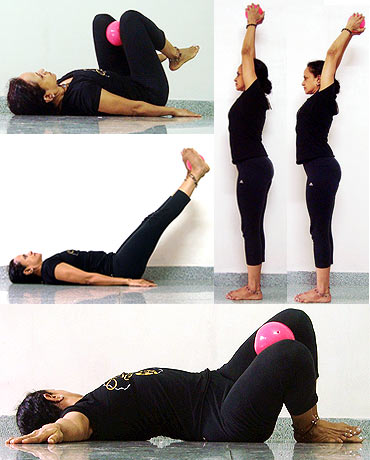
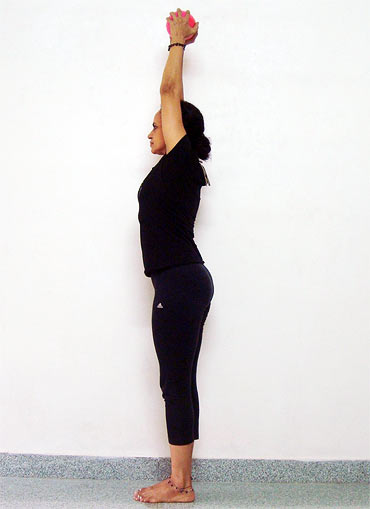
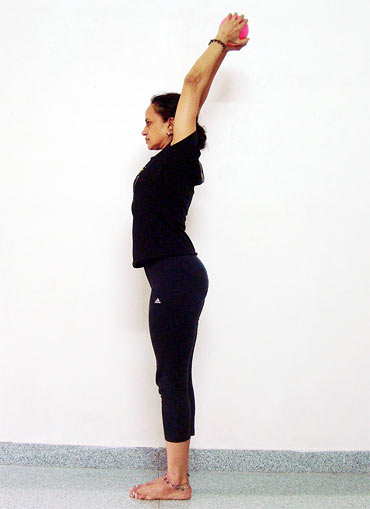
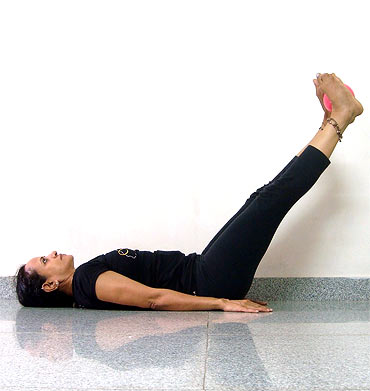
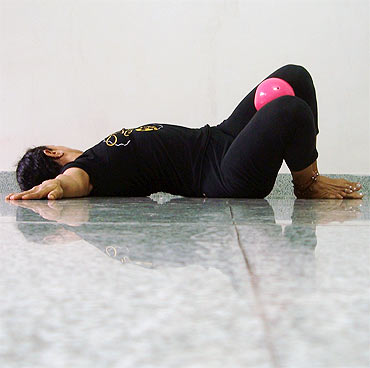
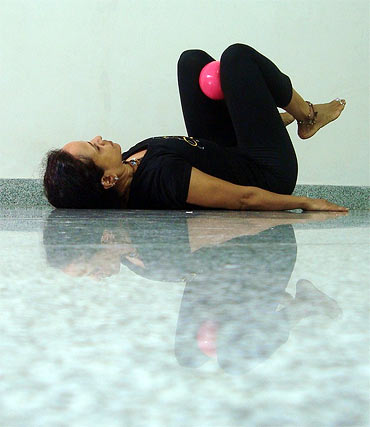
Comment
article